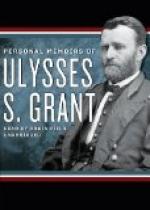A few days out from Corpus Christi, the immense herd of wild horses that ranged at that time between the Nueces and the Rio Grande was seen directly in advance of the head of the column and but a few miles off. It was the very band from which the horse I was riding had been captured but a few weeks before. The column was halted for a rest, and a number of officers, myself among them, rode out two or three miles to the right to see the extent of the herd. The country was a rolling prairie, and, from the higher ground, the vision was obstructed only by the earth’s curvature. As far as the eye could reach to our right, the herd extended. To the left, it extended equally. There was no estimating the number of animals in it; I have no idea that they could all have been corralled in the State of Rhode Island, or Delaware, at one time. If they had been, they would have been so thick that the pasturage would have given out the first day. People who saw the Southern herd of buffalo, fifteen or twenty years ago, can appreciate the size of the Texas band of wild horses in 1846.
At the point where the army struck the Little Colorado River, the stream was quite wide and of sufficient depth for navigation. The water was brackish and the banks were fringed with timber. Here the whole army concentrated before attempting to cross. The army was not accompanied by a pontoon train, and at that time the troops were not instructed in bridge building. To add to the embarrassment of the situation, the army was here, for the first time, threatened with opposition. Buglers, concealed from our view by the brush on the opposite side, sounded the “assembly,” and other military calls. Like the wolves before spoken of, they gave the impression that there was a large number of them and that, if the troops were in proportion to the noise, they were sufficient to devour General Taylor and his army. There were probably but few troops, and those engaged principally in watching the movements of the “invader.” A few of our cavalry dashed in, and forded and swam the stream, and all opposition was soon dispersed. I do not remember that a single shot was fired.
The troops waded the stream, which was up to their necks in the deepest part. Teams were crossed by attaching a long rope to the end of the wagon tongue passing it between the two swing mules and by the side of the leader, hitching his bridle as well as the bridle of the mules in rear to it, and carrying the end to men on the opposite shore. The bank down to the water was steep on both sides. A rope long enough to cross the river, therefore, was attached to the back axle of the wagon, and men behind would hold the rope to prevent the wagon “beating” the mules into the water. This latter rope also served the purpose of bringing the end of the forward one back, to be used over again. The water was deep enough for a short distance to swim the little Mexican mules which the army was then using, but they, and the wagons, were pulled through so fast by the men at the end of the rope ahead, that no time was left them to show their obstinacy. In this manner the artillery and transportation of the “army of occupation” crossed the Colorado River.




